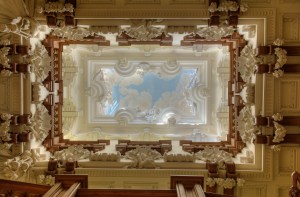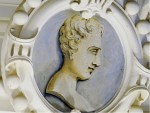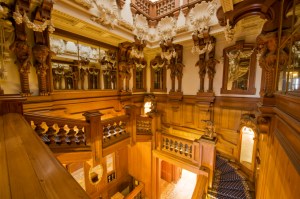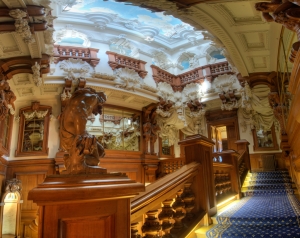This is possibly the most remarkable and magnificent staircase in England. In the style of Italian baroque, its decoration and design offer endless stimulation to the imagination, with the essential effect of deceiving the eye. The impression of great height is achieved by means of a clerestory above the roof and is reminiscent of an 18th century German pilgrimage church. There is a false but attractive appearance of a gallery. Even though we are but one storey up in a three storey building (the actual rise is only from first to second floor), we are given the effect of three more main floors.
The plasterwork was possibly executed by the firm of Francis Bernasconi of London. Two “Fathers Time” peer at us from the sky; one with a genuine scythe and the other has a scroll bearing the floor plan of the Manor.
There is also a roundel portrait, thought to be of Gregory (Pevsner, 1989). All about the landings and stairway are drapes and billows of what appear to be cloth, but are in fact plaster. The ropes appearing to be plaster are actually rope dipped in gypsum, sand and water, with animal hair used as a binding agent. Cherubs, bronzes, Atlas figures, caryatids, putti, and cockleshells constitute one of the most fantastic and extravagant expressions of Baroque style in the country.
The woodwork is all cedar, retaining its distinctive aroma after more than 100 years. Records show that the balustrades were made in the village. The side mirrors added in the 1980s replaced fabric-covered panels. The floor is made up of French pietra dura acquired by Gregory Gregory on his European travels. There is a Gregory crest over the Ante Room door.




